Understanding the Components of Your Toilet: A Comprehensive Guide to Toilet Parts and Maintenance

Toilets are a vital component of any bathroom, but it’s common for us to overlook the individual parts that make up this essential fixture. When your toilet encounters issues, knowing the names and functions of each part is crucial for effective troubleshooting and repair. In this guide, we will take an in-depth look at the various components of a toilet, including both the toilet tank and bowl, to help you better understand how your toilet works and how to fix common problems.
Demystifying the Toilet Tank: Exploring its Key Components
The toilet tank is the large container located above and behind the toilet bowl that stores water for flushing waste down the drain. Most of the essential working parts of a toilet are housed within the tank. Understanding these components will empower you to tackle any issues that may arise.
Key Parts of the Toilet Tank
Toilet Handle
The toilet handle, often a lever or set of buttons located on the front, side, or top of the tank, is used to initiate the flushing process. Issues with the toilet handle are usually related to internal mechanisms like the chain or flapper. If your handle feels loose, you can easily tighten it by following a few simple steps.
- Tip: Always empty the water from the tank before working on the handle to avoid any accidents.
Toilet Chain and Lift Wire
The toilet chain and lift wire work in tandem to lift the flapper, allowing water to flow from the tank into the bowl. Snags or detachment of the chain can lead to flushing problems, but resolving these issues is relatively straightforward.
Toilet Flapper or Flap Valve
The toilet flapper is a flexible rubber valve that opens to release water from the tank into the bowl during flushing. Over time, the flapper may harden and lose its effectiveness, leading to hissing sounds and potential leaks.
- Tip: A hissing sound is often a sign of a faulty flapper that needs replacement.
Toilet Fill Valve
The toilet fill valve is a vertical tube that regulates water flow into the tank and monitors water levels. Cracks in the fill tube can cause leaks, necessitating a replacement to maintain proper functionality.
Toilet Float or Ballcock
The toilet float, an older mechanism now replaced by refill valves in newer toilets, manages the water level within the tank. Symptoms like continuous running or incomplete filling indicate a need to replace the float.
Toilet Overflow Tube
The toilet overflow tube, also known as the flush valve, is a vertical tube that prevents tank overflow and determines the water level in the bowl for subsequent flushes.
Maintaining and Repairing Toilet Tank Components
From fixing a loose handle to replacing a worn-out flapper, understanding how each component works and how to address common issues will help you keep your toilet in optimal condition.
Exploring the Components of the Toilet Bowl: A Closer Look at its Functionality
The toilet bowl, the lower base that collects waste and where users sit, is a crucial part of the toilet that is usually made of durable materials like vitreous china. While the bowl itself has no moving parts, there are essential components that play a role in its performance.
Essential Parts of the Toilet Bowl
Toilet Tank O-Ring Seal
The O-ring seal, positioned between the tank and bowl, prevents water leakage. Any issues with this seal can result in leaks, which can be addressed by replacing the O-ring seal correctly.
Toilet Wax or Silicone Seal
The wax seal, or silicone variant, creates a watertight seal between the bowl and the floor. Maintenance of this seal is vital to prevent leaks and maintain the integrity of the toilet’s installation.
- Tip: Extra-thick wax rings or flange extenders can help address height and spacing issues during installation.
Toilet Floor Flange
The floor flange secures the toilet to the floor via screws and bolts, ensuring stability and preventing leaks. Damaged flanges can be replaced to maintain the toilet’s structural integrity.
Tips for Maintaining Your Toilet Bowl
Regular maintenance of the toilet bowl components, such as the seals and flange, is essential to prevent leaks and ensure proper functionality. Understanding how these parts work together will enable you to identify and address any issues promptly.
Troubleshooting Common Toilet Problems: A Step-by-Step Guide
From a malfunctioning handle to a leaking seal, addressing common toilet issues requires a systematic approach. Here are some troubleshooting steps to help you resolve common problems with your toilet:
-
Toilet Handle Issues:
- If the handle feels loose, tighten it by following the instructions provided.
-
Flapper Replacement:
- If you hear hissing sounds or notice water leaks, replacing the flapper may solve the issue.
-
Seal Maintenance:
- Regularly check and replace the O-ring and wax seals to prevent water leaks between the tank and bowl.
-
Floor Flange Repair:
- Address any leaks around the base of the toilet by inspecting and replacing the floor flange if necessary.
By understanding the key components of your toilet and learning how to troubleshoot common problems, you can ensure that your toilet operates smoothly and efficiently.
Conclusion: Mastering Toilet Maintenance for a Well-Functioning Bathroom
In conclusion, familiarizing yourself with the various parts of your toilet and their functions is essential for effective maintenance and troubleshooting. By following the tips and guidelines outlined in this comprehensive guide, you can confidently address common toilet issues and keep your bathroom in optimal working condition. Remember, regular maintenance and timely repairs are key to ensuring the longevity and efficiency of your toilet. Happy flushing!





